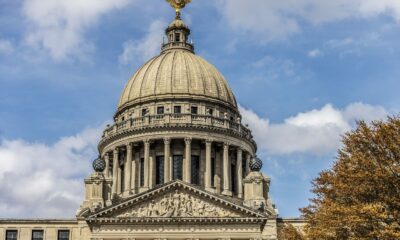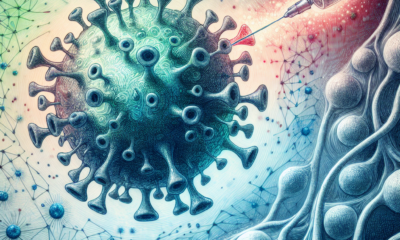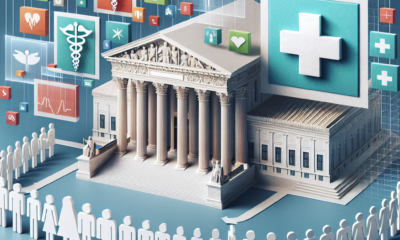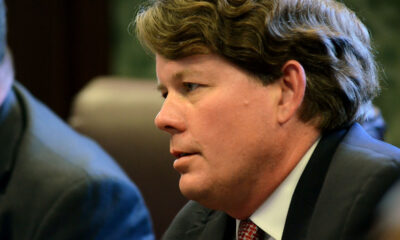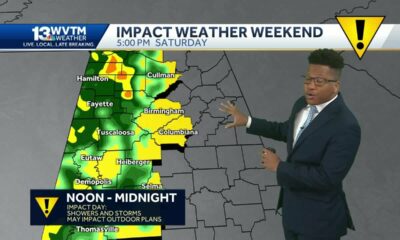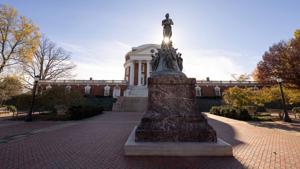Kaiser Health News
RFK Jr.’s Campaign of Conspiracy Theories Is PolitiFact’s 2023 Lie of the Year
Madison Czopek, PolitiFact and Katie Sanders, PolitiFact
Wed, 27 Dec 2023 10:00:00 +0000
As pundits and politicos spar over whether Robert F. Kennedy Jr.’s presidential campaign will factor into the outcome of the 2024 election, one thing is clear: Kennedy’s political following is built on a movement that seeks to legitimize conspiracy theories.
His claims decrying vaccines have roiled scientists and medical experts and stoked anger over whether his work harms children. He has made suggestions about the cause of covid-19 that he acknowledges sound racist and antisemitic.
Bolstered by his famous name and family’s legacy, his campaign of conspiracy theories has gained an electoral and financial foothold. He is running as an independent — having abandoned his pursuit of the Democratic Party nomination — and raised more than $15 million. A political action committee pledged to spend between $10 million and $15 million to get his name on the ballot in 10 states.
Even though he spent the past two decades as a prominent leader of the anti-vaccine movement, Kennedy rejects a blanket “anti-vax” label that he told Fox News in July makes him “look crazy, like a conspiracy theorist.”
But Kennedy draws bogus conclusions from scientific work. He employs “circumstantial evidence” as if it is proof. In TV, podcast, and political appearances for his campaign in 2023, Kennedy steadfastly maintained:
- Vaccines cause autism.
- No childhood vaccines “have ever been tested in a safety study pre-licensing.”
- There is “tremendous circumstantial evidence” that psychiatric drugs cause mass shootings, and the National Institutes of Health refuses to research the link out of deference to pharmaceutical companies.
- Ivermectin and hydroxychloroquine were discredited as covid-19 treatments so covid vaccines could be granted emergency use authorization, a win for Big Pharma.
- Exposure to the pesticide atrazine contributes to gender dysphoria in children.
- Covid-19 is “targeted to attack Caucasians and Black people. The people who are most immune are Ashkenazi Jews and Chinese.”
For Kennedy, the conspiracies aren’t limited to public health. He claims “members of the CIA” were involved in the assassination of his uncle, John F. Kennedy. He doesn’t “believe that (Sirhan) Sirhan’s bullets ever hit my father,” former Attorney General Robert F. Kennedy. He insists the 2004 presidential election was stolen from Democratic candidate John Kerry.
News organizations, including PolitiFact, have documented why those claims, and many others, are false, speculative, or conspiracy-minded.
Kennedy has sat for numerous interviews and dismissed the critics, not with the grievance and bluster of former President Donald Trump, but with a calm demeanor. He amplifies the alleged plot and repeats dubious scientific evidence and historical detail.
Will his approach translate to votes? In polls since November of a three-way matchup between President Joe Biden, Trump, and Kennedy, Kennedy pulled 16% to 22% of respondents.
Kennedy’s movement exemplifies the resonance of conspiratorial views. Misinformers with organized efforts are rewarded with money and loyalty. But that doesn’t make the claims true.
Robert F. Kennedy Jr.’s campaign based on false theories is PolitiFact’s 2023 Lie of the Year.
How an Environmental Fighter Took Up Vaccines
Kennedy, the third of 11 children, was 9 when he was picked up on Nov. 22, 1963, from Sidwell Friends School in Washington, D.C., because Lee Harvey Oswald had shot and killed Uncle Jack. He was 14 when he learned that his father had been shot by Sirhan Sirhan following a victory speech after the California Democratic presidential primary.
RFK Jr., who turns 70 in January, wouldn’t begin to publicly doubt the government’s findings about the assassinations until later in his adulthood.
As a teenager, he used drugs. He was expelled from two boarding schools and arrested at 16 for marijuana possession. None of that slowed an elite path through higher education, including Harvard University for his bachelor’s degree and the University of Virginia for his law degree.
He was hired as an assistant district attorney in Manhattan in 1982 but failed the bar exam and resigned the next year. Two months later, he was arrested for heroin possession after falling ill on a flight. His guilty plea involved a drug treatment program, a year of probation, and volunteer work with a local anglers’ association that patrolled the Hudson River for evidence of pollution that could lead to lawsuits.
Kennedy’s involvement with Hudson Riverkeeper and the Natural Resources Defense Council ushered in a long chapter of environmental litigation and advocacy.
An outdoorsman and falconer, Kennedy sued companies and government agencies over pollution in the Hudson River and its watershed. (He joined the New York bar in 1985.) He earned a master’s degree in environmental law at Pace University, where he started a law clinic to primarily assist Riverkeeper’s legal work. He helped negotiate a 1997 agreement that protected upstate New York reservoirs supplying New York City’s drinking water.
In 1999, Kennedy founded the Waterkeeper Alliance, an international group of local river and bay-keeper organizations that act as their “community’s coast guard,” he told Vanity Fair in 2016. He stayed with the group until 2020, when he left “to devote himself, full-time, to other issues.”
On Joe Rogan’s podcast in June, Kennedy said that virtually all of his litigation involved “some scientific controversy. And so, I’m comfortable with reading science and I know how to read it critically.”
PolitiFact did not receive a response from Kennedy’s campaign for this story.
He became concerned about mercury pollution from coal-burning power plants; methylmercury can build up in fish, posing a risk to humans and wildlife. As he traveled around the country, he said, women started appearing in the front rows of his mercury lectures.
“They would say to me in kind of a respectful but vaguely scolding way, ‘If you’re really interested in mercury contamination exposure to children, you need to look at the vaccines,’” Kennedy told Rogan, whose show averages 11 million listeners an episode.
Kennedy said the women sounded “rational” as they explained a link between their children’s autism and vaccines. “They weren’t excitable,” he said. “And they had done their research, and I was like, ‘I should be listening to these people, even if they’re wrong.’”
He did more than listen. In June 2005, Rolling Stone and Salon co-published Kennedy’s article “Deadly Immunity.” Kennedy told an alarming story about a study that revealed a mercury-based additive once used in vaccines, thimerosal, “may have caused autism in thousands of kids.” Kennedy alleged that preeminent health agencies — the Centers for Disease Control and Prevention, the Food and Drug Administration, the World Health Organization — had colluded with vaccine manufacturers “to conceal the data.”
Kennedy’s premise was decried as inaccurate and missing context. He left out the ultimate conclusion of the 2003 study, by Thomas Verstraeten, which said “no consistent significant associations were found between [thimerosal-containing vaccines] and neurodevelopmental outcomes.”
Kennedy didn’t clearly state that, as a precaution, thimerosal was not being used in childhood vaccines when his article was published. He also misrepresented the comments of health agency leaders at a June 2000 meeting, pulling certain portions of a 286-page transcript that appeared to support Kennedy’s collusion narrative.
Scientists who have studied thimerosal have found no evidence that the additive, used to prevent germ growth, causes harm, according to a CDC FAQ about thimerosal. Unlike the mercury in some fish, the CDC says, thimerosal “doesn’t stay in the body, and is unlikely to make us sick.” Continued research has not established a link between thimerosal and autism.
By the end of July 2005, Kennedy’s Salon article had been appended with five correction notes. In 2011, Salon retracted the article. It disappeared from Rolling Stone.
Salon’s retraction was part of a broader conspiracy of caving “under pressure from the pharmaceutical industry,” Kennedy told Rogan. The then-Salon editor rejected this, saying they “caved to pressure from the incontrovertible truth and our journalistic consciences.”
Kennedy has not wavered in his belief: “Well, I do believe that autism does come from vaccines,” he told Fox News’ Jesse Watters in July.
David Remnick, editor of The New Yorker, interviewed Kennedy for a July story. Noting that Kennedy was focusing more on vaccine testing rather than outright opposition, Remnick asked him whether he was having second thoughts.
“I’ve read the science on autism and I can tell you, if you want to know,” Kennedy said. “David, you’ve got to answer this question: If it didn’t come from the vaccines, then where is it coming from?”
How Covid-19 Helped RFK Jr.’s Vaccine-Skeptical Crusade
In 2016, Kennedy launched the World Mercury Project to address mercury in fish, medicines, and vaccines. In 2018, he created Children’s Health Defense, a legal advocacy group that works “aggressively to eliminate harmful exposures,” its website says.
Since at least 2019, Children’s Health Defense has supported and filed lawsuits challenging vaccination requirements, mask mandates, and social media companies’ misinformation policies (including a related lawsuit against Facebook and The Poynter Institute, which owns PolitiFact).
From the beginning, the group has solicited stories about children “injured” by environmental toxins or vaccines. This year, it launched a national bus tour to collect testimonials. The organization also produces documentary-style films and books, including Kennedy’s “The Wuhan Cover-Up and the Terrifying Bioweapons Arms Race” and “The Real Anthony Fauci: Bill Gates, Big Pharma, and the Global War on Democracy and Public Health.”
In 2020, Children’s Health Defense and the anti-vaccine movement turned attention to the emerging public health crisis.
Kolina Koltai, a senior researcher at Bellingcat, an investigative journalism group, had seen anti-vaccine groups try to seize on Zika and Ebola outbreaks, with little success. But the covid-19 pandemic provided “the exact scenario” needed to create mass dissent: widespread fear and an information vacuum.
Children’s Health Defense published articles in March and April 2020 claiming the “viral terror” was an attempt to enact the “global immunization agenda” and a “dream come true” for dictators. The group echoed these points in ads and social media posts and grew its audience, including in Europe.
On X, then known as Twitter, Children’s Health Defense outperformed news outlets that met NewsGuard’s criteria for trustworthiness from the third quarter of 2020 to the fourth quarter of 2021, according to a report by the German Marshall Fund think tank, even as Children’s Health Defense published debunked information about covid-19 and vaccines.
In 2019, Children’s Health Defense reported it had $2.94 million in revenue, and paid Kennedy a $255,000 salary. Its revenue grew 440% through 2021, according to IRS filings, hitting $15.99 million. Kennedy’s salary increased to $497,013. (Its 2022 form 990 for tax disclosure is not yet public. Kennedy has been on leave from the organization since he entered the presidential race in April.)
On social media, the message had limits. Meta removed Kennedy’s personal Instagram account in February 2021 for spreading false claims about covid-19 and vaccines, the company said, but left his Facebook account active. A year and a half later, Meta banned Children’s Health Defense’s main Facebook and Instagram accounts for “repeatedly” violating its medical misinformation policies. Several state chapters still have accounts.
As the group’s face, Kennedy became a leader of a movement opposed to masks and stay-at-home orders, said David H. Gorski, managing editor of Science-Based Medicine and a professor of surgery and oncology at the Wayne State University School of Medicine.
“The pandemic produced a new generation of anti-vaxxers who had either not been prominent before or who were not really anti-vax before,” Gorski said. “But none of them had the same cultural cachet that comes with being a Kennedy that RFK Jr. has.”
Rallying a crowd before the Lincoln Memorial on Jan. 23, 2022, Kennedy protested covid-19 countermeasures alongside commentator Lara Logan and anti-vaccine activist Robert Malone. The crowd held signs reading “Nuremberg Trials 2.0” and “free choice, no masks, no tests, no vax.” When Kennedy took the stage, mention of his role with Children’s Health Defense prompted an exuberant cheer.
In his speech, Kennedy invoked the Holocaust to denounce the “turnkey totalitarianism” of a society that requires vaccinations to travel, uses digital currency and 5G, and is monitored by Microsoft Corp. co-founder Bill Gates’ satellites: “Even in Hitler’s Germany, you could cross the Alps into Switzerland. You could hide in an attic like Anne Frank did.”
Days later, facing criticism from his wife, the actor Cheryl Hines, Jewish advocacy groups, and Holocaust memorial organizations, Kennedy issued a rare apology for his comments.
Asked about his wife’s comment on Dec. 15 on CNN, he said his remarks were taken out of context but that he had to apologize because of his family.
Recycle. Repeat. Repeat.
When he’s asked about his views, Kennedy calmly searches his rhetorical laboratory for recycled talking points, selective research findings, the impression of voluminous valid studies, speculation, and inarguable authority from his experience. He refers to institutions, researchers, and reports, by name, in quick succession, shifting points before interviewers can note what was misleading or cherry-picked.
There is power in repetition. Take his persistent claim that vaccines are not safety-tested.
- In July, he told “Fox & Friends,” “Vaccines are the only medical product that is not safety-tested prior to licensure.”
- On Nov. 7 on PBS NewsHour, Kennedy said vaccines are “the only medical product or medical device that is allowed to get a license without engaging in safety tests.”
- On Dec. 15, he told CNN’s Kasie Hunt that no childhood vaccines have “ever been tested in a safety study pre-licensing.”
This is false. Vaccines, including the covid-19 vaccines, are tested for safety and effectiveness before they are licensed. Researchers gather initial safety data and information about side effects during phase 1 clinical trials on groups of 20 to 100 people. If no safety concerns are identified, subsequent phases rely on studies of larger numbers of volunteers to evaluate a vaccine’s effectiveness and monitor side effects.
Kennedy sometimes says that some vaccines weren’t tested against inactive injections or placebos. That has an element of truth: If using a placebo would disadvantage or potentially endanger a patient, researchers might test new vaccines against older versions with known side effects.
But vaccines are among “the most tested and vetted” pharmaceutical products given to children, said Patricia Stinchfield, a pediatric nurse practitioner and the president of the National Foundation for Infectious Diseases.
Kennedy encourages parents to research questions on their own, saying doctors and other experts are invariably compromised.
“They are taking as gospel what the CDC tells them,” Kennedy said on Bari Weiss’ “Honestly” podcast in June.
Public health agencies have been “serving the mercantile interests of the pharmaceutical companies, and you cannot believe anything that they say,” Kennedy said.
Experts fret that the Kennedy name carries weight.
“When he steps forward and he says the government’s lying to you, the FDA is lying to you, the CDC is lying to you, he has credence, because he’s seen as someone who is a product of the government,” said Paul Offit, a pediatrics professor in the Children’s Hospital of Philadelphia’s infectious diseases division and the director of the hospital’s Vaccine Education Center. “He’s like a whistleblower in that sense. He’s been behind the scenes, so he knows what it looks like, and he’s telling you that you’re being lied to.”
Kennedy name-drops studies that don’t support his commentary. When speaking with Rogan, Kennedy encouraged the podcaster’s staff to show a particular 2010 study that found that exposure to the herbicide atrazine caused some male frogs to develop female sex organs and become infertile.
Kennedy has repeatedly invoked that frog study to support his position that “we should all be looking at” atrazine and its impact on human beings. The researcher behind the study told PolitiFact in June that Kennedy’s atrazine claims were “speculation” given the vast differences between humans and amphibians. No scientific studies in humans link atrazine exposure to gender dysphoria.
In July, Kennedy floated the idea that covid-19 could have been “ethnically targeted” to “attack Caucasians and Black people. The people who are most immune are Ashkenazi Jews and Chinese.” The claim was ridiculously wrong, but Kennedy insisted that it was backed by a July 2020 study by Chinese researchers. That study didn’t find that Chinese people were less affected by the virus. It said one of the virus’s receptors seemed to be absent in the Amish and in Ashkenazi Jews and theorized that genetic factors might increase covid-19 severity.
Five months later, Kennedy invoked the study and insisted he was right: “I can understand why people were disturbed by those remarks. They certainly weren’t antisemitic. … I was talking about a true study, an NIH-funded study.”
“I wish I hadn’t said them, but, you know, what I said was true.”
Kennedy answered using scientific terms (“furin cleave,” “ACE2 receptor”), but he ignored explanations found in the study. He didn’t account for how the original virus has evolved since 2020, or how the study emphasized these potential mutations were rare and would have little to no public health impact.
Public health experts say that racial disparities in covid-19 infection and mortality — in the U.S., Black and Hispanic people often faced more severe covid-19 outcomes — resulted from social and economic inequities, not genetics.
Kennedy says “circumstantial evidence” is enough.
Antidepressants are linked to school shootings, he told listeners on a livestream hosted by Elon Musk. The government should have begun studying the issue years ago, he said, because “there’s tremendous circumstantial evidence that those, like SSRIs and benzos and other drugs, are doing this.”
Experts in psychiatry have told PolitiFact and other fact-checkers that there is no causal relationship between antidepressants and shootings. With 13% of the adult population using antidepressants, experts say that if the link were true they would expect higher rates of violence. Also, the available data on U.S. school shootings shows most shooters were not using psychiatric medicines, which have an anti-violence effect.
Conspiracy Theories, Consequences, and a Presidential Campaign
The anti-censorship candidate frames his first bid for public office as a response to “18 years” of being shunned for his views — partly by the government, but also by private companies.
“You’re protected so much from censorship if you’re running for president,” Kennedy told conservative Canadian podcaster and psychologist Jordan Peterson in June.
In June, Kennedy’s Instagram account was reinstated — with a verified badge noting he is a public figure. Meta’s rules on misinformation do not apply to active political candidates. (PolitiFact is a partner of Meta’s Third Party Fact-Checking Program, which seeks to reduce false content on the platform.)
In July, he was invited to testify before the Republican-led House Select Subcommittee on the Weaponization of the Federal Government. He repeated that he had “never been anti-vax,” and railed against the Biden White House for asking Twitter to remove his January 2021 tweet that said Baseball Hall of Famer Hank Aaron’s death was “part of a wave of suspicious deaths among elderly,” weeks after Aaron, 86, received a covid-19 vaccine. The medical examiner’s office said Aaron died from unrelated natural causes.
Throughout 2023, alternative media has embraced Kennedy. He has regularly appeared on podcasts such as Peterson’s, and has also participated in profiles by mainstream TV, online, and print sources.
“You’re like, ‘But you’re talking right now. I’m listening to you. I hear your words. You’re not being censored,’” said Whitney Phillips, an assistant professor in the School of Journalism and Communication at the University of Oregon who researches how news media covers conspiracy theories and their proponents. “But a person can believe they’re being censored because they’ve internalized that they’re going to be,” or they know making the claim will land with their audience.
Time will tell whether his message resonates with voters.
Kyle Kondik, managing editor of Sabato’s Crystal Ball at the University of Virginia Center for Politics, said Kennedy may be a “placeholder” for voters who are dissatisfied with Trump and Biden and will take a third option when offered by pollsters.
The only 2024 candidate whose favorability ratings are more positive than negative? It’s Kennedy, according to FiveThirtyEight. However, a much higher percentage of voters are unfamiliar with him than they are with Trump or Biden — about a quarter — and Kennedy’s favorability edge has decreased as his campaign has gone on.
Nevertheless, third-party candidates historically finish with a fraction of their polling, Kondik said, and voters will likely have more names and parties on their fall ballots, including philosopher Cornel West, physician Jill Stein, and a potential slate from the No Labels movement.
Kennedy was popular with conservative commentators before he became an independent, and he has avoided pointedly criticizing Trump, except on covid-19 lockdowns. When NBC News asked Kennedy in August what he thought of Trump’s 2020 election lies, Kennedy said he believed Trump lost, but that, in general, people who believe elections were stolen “should be listened to.” Kennedy is one of them. He still says that the 2004 presidential election was “stolen” from Kerry in favor of Republican George W. Bush, though it wasn’t.
American Values 2024 will spend up to $15 million to get Kennedy’s name on the ballot in 10 states including Arizona, California, Indiana, New York, and Texas. Those are five of the toughest states for ballot access, said Richard Winger, co-editor of Ballot Access News.
Four of Kennedy’s siblings called Kennedy’s decision to run as an independent “dangerous” and “perilous” to the nation. “Bobby might share the same name as our father, but he does not share the same values, vision or judgment,” the group wrote in a joint statement.
Kennedy brushes it off when asked, saying he has a large family and some members support him.
On her podcast, Weiss asked whether Kennedy worried his position on autism and vaccines would cloud his other positions and cost him votes. His answer ignored his history.
“Show me where I got it wrong,” he said, “and I’ll change.”
In a campaign constructed by lies, that might be the biggest one.
PolitiFact researcher Caryn Baird contributed to this report.
PolitiFact’s source list can be found here.
——————————
By: Madison Czopek, PolitiFact and Katie Sanders, PolitiFact
Title: RFK Jr.’s Campaign of Conspiracy Theories Is PolitiFact’s 2023 Lie of the Year
Sourced From: kffhealthnews.org/news/article/rfk-kennedy-politifact-lie-of-year-2023-autism-vaccines/
Published Date: Wed, 27 Dec 2023 10:00:00 +0000
Kaiser Health News
US Judge Names Receiver To Take Over California Prisons’ Mental Health Program
SACRAMENTO, Calif. — A judge has initiated a federal court takeover of California’s troubled prison mental health system by naming the former head of the Federal Bureau of Prisons to serve as receiver, giving her four months to craft a plan to provide adequate care for tens of thousands of prisoners with serious mental illness.
Senior U.S. District Judge Kimberly Mueller issued her order March 19, identifying Colette Peters as the nominated receiver. Peters, who was Oregon’s first female corrections director and known as a reformer, ran the scandal-plagued federal prison system for 30 months until President Donald Trump took office in January. During her tenure, she closed a women’s prison in Dublin, east of Oakland, that had become known as the “rape club.”
Michael Bien, who represents prisoners with mental illness in the long-running prison lawsuit, said Peters is a good choice. Bien said Peters’ time in Oregon and Washington, D.C., showed that she “kind of buys into the fact that there are things we can do better in the American system.”
“We took strong objection to many things that happened under her tenure at the BOP, but I do think that this is a different job and she’s capable of doing it,” said Bien, whose firm also represents women who were housed at the shuttered federal women’s prison.
California corrections officials called Peters “highly qualified” in a statement, while Gov. Gavin Newsom’s office did not immediately comment. Mueller gave the parties until March 28 to show cause why Peters should not be appointed.
Peters is not talking to the media at this time, Bien said. The judge said Peters is to be paid $400,000 a year, prorated for the four-month period.
About 34,000 people incarcerated in California prisons have been diagnosed with serious mental illnesses, representing more than a third of California’s prison population, who face harm because of the state’s noncompliance, Mueller said.
Appointing a receiver is a rare step taken when federal judges feel they have exhausted other options. A receiver took control of Alabama’s correctional system in 1976, and they have otherwise been used to govern prisons and jails only about a dozen times, mostly to combat poor conditions caused by overcrowding. Attorneys representing inmates in Arizona have asked a judge to take over prison health care there.
Mueller’s appointment of a receiver comes nearly 20 years after a different federal judge seized control of California’s prison medical system and installed a receiver, currently J. Clark Kelso, with broad powers to hire, fire, and spend the state’s money.
California officials initially said in August that they would not oppose a receivership for the mental health program provided that the receiver was also Kelso, saying then that federal control “has successfully transformed medical care” in California prisons. But Kelso withdrew from consideration in September, as did two subsequent candidates. Kelso said he could not act “zealously and with fidelity as receiver in both cases.”
Both cases have been running for so long that they are now overseen by a second generation of judges. The original federal judges, in a legal battle that reached the U.S. Supreme Court, more than a decade ago forced California to significantly reduce prison crowding in a bid to improve medical and mental health care for incarcerated people.
State officials in court filings defended their improvements over the decades. Prisoners’ attorneys countered that treatment remains poor, as evidenced in part by the system’s record-high suicide rate, topping 31 suicides per 100,000 prisoners, nearly double that in federal prisons.
“More than a quarter of the 30 class-members who died by suicide in 2023 received inadequate care because of understaffing,” prisoners’ attorneys wrote in January, citing the prison system’s own analysis. One prisoner did not receive mental health appointments for seven months “before he hanged himself with a bedsheet.”
They argued that the November passage of a ballot measure increasing criminal penalties for some drug and theft crimes is likely to increase the prison population and worsen staffing shortages.
California officials argued in January that Mueller isn’t legally justified in appointing a receiver because “progress has been slow at times but it has not stalled.”
Mueller has countered that she had no choice but to appoint an outside professional to run the prisons’ mental health program, given officials’ intransigence even after she held top officials in contempt of court and levied fines topping $110 million in June. Those extreme actions, she said, only triggered more delays.
The 9th U.S. Circuit Court of Appeals on March 19 upheld Mueller’s contempt ruling but said she didn’t sufficiently justify calculating the fines by doubling the state’s monthly salary savings from understaffing prisons. It upheld the fines to the extent that they reflect the state’s actual salary savings but sent the case back to Mueller to justify any higher penalty.
Mueller had been set to begin additional civil contempt proceedings against state officials for their failure to meet two other court requirements: adequately staffing the prison system’s psychiatric inpatient program and improving suicide prevention measures. Those could bring additional fines topping tens of millions of dollars.
But she said her initial contempt order has not had the intended effect of compelling compliance. Mueller wrote as far back as July that additional contempt rulings would also be likely to be ineffective as state officials continued to appeal and seek delays, leading “to even more unending litigation, litigation, litigation.”
She went on to foreshadow her latest order naming a receiver in a preliminary order: “There is one step the court has taken great pains to avoid. But at this point,” Mueller wrote, “the court concludes the only way to achieve full compliance in this action is for the court to appoint its own receiver.”
This article was produced by KFF Health News, which publishes California Healthline, an editorially independent service of the California Health Care Foundation.
If you or someone you know may be experiencing a mental health crisis, contact the 988 Suicide & Crisis Lifeline by dialing or texting “988.”
The post US Judge Names Receiver To Take Over California Prisons’ Mental Health Program appeared first on kffhealthnews.org
Kaiser Health News
Amid Plummeting Diversity at Medical Schools, a Warning of DEI Crackdown’s ‘Chilling Effect’
The Trump administration’s crackdown on DEI programs could exacerbate an unexpectedly steep drop in diversity among medical school students, even in states like California, where public universities have been navigating bans on affirmative action for decades. Education and health experts warn that, ultimately, this could harm patient care.
Since taking office, President Donald Trump has issued a handful of executive orders aimed at terminating all diversity, equity, and inclusion, or DEI, initiatives in federally funded programs. And in his March 4 address to Congress, he described the Supreme Court’s 2023 decision banning the consideration of race in college and university admissions as “brave and very powerful.”
Last month, the Education Department’s Office for Civil Rights — which lost about 50% of its staff in mid-March — directed schools, including postsecondary institutions, to end race-based programs or risk losing federal funding. The “Dear Colleague” letter cited the Supreme Court’s decision.
Paulette Granberry Russell, president and CEO of the National Association of Diversity Officers in Higher Education, said that “every utterance of ‘diversity’ is now being viewed as a violation or considered unlawful or illegal.” Her organization filed a lawsuit challenging Trump’s anti-DEI executive orders.
While California and eight other states — Arizona, Florida, Idaho, Michigan, Nebraska, New Hampshire, Oklahoma, and Washington — had already implemented bans of varying degrees on race-based admissions policies well before the Supreme Court decision, schools bolstered diversity in their ranks with equity initiatives such as targeted scholarships, trainings, and recruitment programs.
But the court’s decision and the subsequent state-level backlash — 29 states have since introduced bills to curb diversity initiatives, according to data published by the Chronicle of Higher Education — have tamped down these efforts and led to the recent declines in diversity numbers, education experts said.
After the Supreme Court’s ruling, the numbers of Black and Hispanic medical school enrollees fell by double-digit percentages in the 2024-25 school year compared with the previous year, according to the Association of American Medical Colleges. Black enrollees declined 11.6%, while the number of new students of Hispanic origin fell 10.8%. The decline in enrollment of American Indian or Alaska Native students was even more dramatic, at 22.1%. New Native Hawaiian or other Pacific Islander enrollment declined 4.3%.
“We knew this would happen,” said Norma Poll-Hunter, AAMC’s senior director of workforce diversity. “But it was double digits — much larger than what we anticipated.”
The fear among educators is the numbers will decline even more under the new administration.
At the end of February, the Education Department launched an online portal encouraging people to “report illegal discriminatory practices at institutions of learning,” stating that students should have “learning free of divisive ideologies and indoctrination.” The agency later issued a “Frequently Asked Questions” document about its new policies, clarifying that it was acceptable to observe events like Black History Month but warning schools that they “must consider whether any school programming discourages members of all races from attending.”
“It definitely has a chilling effect,” Poll-Hunter said. “There is a lot of fear that could cause institutions to limit their efforts.”
Numerous requests for comment from medical schools about the impact of the anti-DEI actions went unreturned. University presidents are staying mum on the issue to protect their institutions, according to reporting from The New York Times.
Utibe Essien, a physician and UCLA assistant professor, said he has heard from some students who fear they won’t be considered for admission under the new policies. Essien, who co-authored a study on the effect of affirmative action bans on medical schools, also said students are worried medical schools will not be as supportive toward students of color as in the past.
“Both of these fears have the risk of limiting the options of schools folks apply to and potentially those who consider medicine as an option at all,” Essien said, adding that the “lawsuits around equity policies and just the climate of anti-diversity have brought institutions to this place where they feel uncomfortable.”
In early February, the Pacific Legal Foundation filed a lawsuit against the University of California-San Francisco’s Benioff Children’s Hospital Oakland over an internship program designed to introduce “underrepresented minority high school students to health professions.”
Attorney Andrew Quinio filed the suit, which argues that its plaintiff, a white teenager, was not accepted to the program after disclosing in an interview that she identified as white.
“From a legal standpoint, the issue that comes about from all this is: How do you choose diversity without running afoul of the Constitution?” Quinio said. “For those who want diversity as a goal, it cannot be a goal that is achieved with discrimination.”
UC Health spokesperson Heather Harper declined to comment on the suit on behalf of the hospital system.
Another lawsuit filed in February accuses the University of California of favoring Black and Latino students over Asian American and white applicants in its undergraduate admissions. Specifically, the complaint states that UC officials pushed campuses to use a “holistic” approach to admissions and “move away from objective criteria towards more subjective assessments of the overall appeal of individual candidates.”
The scrutiny of that approach to admissions could threaten diversity at the UC-Davis School of Medicine, which for years has employed a “race-neutral, holistic admissions model” that reportedly tripled enrollment of Black, Latino, and Native American students.
“How do you define diversity? Does it now include the way we consider how someone’s lived experience may be influenced by how they grew up? The type of school, the income of their family? All of those are diversity,” said Granberry Russell, of the National Association of Diversity Officers in Higher Education. “What might they view as an unlawful proxy for diversity equity and inclusion? That’s what we’re confronted with.”
California Attorney General Rob Bonta, a Democrat, recently joined other state attorneys general to issue guidance urging that schools continue their DEI programs despite the federal messaging, saying that legal precedent allows for the activities. California is also among several states suing the administration over its deep cuts to the Education Department.
If the recent decline in diversity among newly enrolled students holds or gets worse, it could have long-term consequences for patient care, academic experts said, pointing toward the vast racial disparities in health outcomes in the U.S., particularly for Black people.
A higher proportion of Black primary care doctors is associated with longer life expectancy and lower mortality rates among Black people, according to a 2023 study published by the JAMA Network.
Physicians of color are also more likely to build their careers in medically underserved communities, studies have shown, which is increasingly important as the AAMC projects a shortage of up to 40,400 primary care doctors by 2036.
“The physician shortage persists, and it’s dire in rural communities,” Poll-Hunter said. “We know that diversity efforts are really about improving access for everyone. More diversity leads to greater access to care — everyone is benefiting from it.”
This article was produced by KFF Health News, which publishes California Healthline, an editorially independent service of the California Health Care Foundation.
The post Amid Plummeting Diversity at Medical Schools, a Warning of DEI Crackdown’s ‘Chilling Effect’ appeared first on kffhealthnews.org
Kaiser Health News
Tribal Health Leaders Say Medicaid Cuts Would Decimate Health Programs
As Congress mulls potentially massive cuts to federal Medicaid funding, health centers that serve Native American communities, such as the Oneida Community Health Center near Green Bay, Wisconsin, are bracing for catastrophe.
That’s because more than 40% of the about 15,000 patients the center serves are enrolled in Medicaid. Cuts to the program would be detrimental to those patients and the facility, said Debra Danforth, the director of the Oneida Comprehensive Health Division and a citizen of the Oneida Nation.
“It would be a tremendous hit,” she said.
The facility provides a range of services to most of the Oneida Nation’s 17,000 people, including ambulatory care, internal medicine, family practice, and obstetrics. The tribe is one of two in Wisconsin that have an “open-door policy,” Danforth said, which means that the facility is open to members of any federally recognized tribe.
But Danforth and many other tribal health officials say Medicaid cuts would cause service reductions at health facilities that serve Native Americans.
Indian Country has a unique relationship to Medicaid, because the program helps tribes cover chronic funding shortfalls from the Indian Health Service, the federal agency responsible for providing health care to Native Americans.
Medicaid has accounted for about two-thirds of third-party revenue for tribal health providers, creating financial stability and helping facilities pay operational costs. More than a million Native Americans enrolled in Medicaid or the closely related Children’s Health Insurance Program also rely on the insurance to pay for care outside of tribal health facilities without going into significant medical debt. Tribal leaders are calling on Congress to exempt tribes from cuts and are preparing to fight to preserve their access.
“Medicaid is one of the ways in which the federal government meets its trust and treaty obligations to provide health care to us,” said Liz Malerba, director of policy and legislative affairs for the United South and Eastern Tribes Sovereignty Protection Fund, a nonprofit policy advocacy organization for 33 tribes spanning from Texas to Maine. Malerba is a citizen of the Mohegan Tribe.
“So we view any disruption or cut to Medicaid as an abrogation of that responsibility,” she said.
Tribes face an arduous task in providing care to a population that experiences severe health disparities, a high incidence of chronic illness, and, at least in western states, a life expectancy of 64 years — the lowest of any demographic group in the U.S. Yet, in recent years, some tribes have expanded access to care for their communities by adding health services and providers, enabled in part by Medicaid reimbursements.
During the last two fiscal years, five urban Indian organizations in Montana saw funding growth of nearly $3 million, said Lisa James, director of development for the Montana Consortium for Urban Indian Health, during a webinar in February organized by the Georgetown University Center for Children and Families and the National Council of Urban Indian Health.
The increased revenue was “instrumental,” James said, allowing clinics in the state to add services that previously had not been available unless referred out for, including behavioral health services. Clinics were also able to expand operating hours and staffing.
Montana’s five urban Indian clinics, in Missoula, Helena, Butte, Great Falls, and Billings, serve 30,000 people, including some who are not Native American or enrolled in a tribe. The clinics provide a wide range of services, including primary care, dental care, disease prevention, health education, and substance use prevention.
James said Medicaid cuts would require Montana’s urban Indian health organizations to cut services and limit their ability to address health disparities.
American Indian and Alaska Native people under age 65 are more likely to be uninsured than white people under 65, but 30% rely on Medicaid compared with 15% of their white counterparts, according to KFF data for 2017 to 2021. More than 40% of American Indian and Alaska Native children are enrolled in Medicaid or CHIP, which provides health insurance to kids whose families are not eligible for Medicaid. KFF is a health information nonprofit that includes KFF Health News.
A Georgetown Center for Children and Families report from January found the share of residents enrolled in Medicaid was higher in counties with a significant Native American presence. The proportion on Medicaid in small-town or rural counties that are mostly within tribal statistical areas, tribal subdivisions, reservations, and other Native-designated lands was 28.7%, compared with 22.7% in other small-town or rural counties. About 50% of children in those Native areas were enrolled in Medicaid.
The federal government has already exempted tribes from some of Trump’s executive orders. In late February, Department of Health and Human Services acting general counsel Sean Keveney clarified that tribal health programs would not be affected by an executive order that diversity, equity, and inclusion government programs be terminated, but that the Indian Health Service is expected to discontinue diversity and inclusion hiring efforts established under an Obama-era rule.
HHS Secretary Robert F. Kennedy Jr. also rescinded the layoffs of more than 900 IHS employees in February just hours after they’d received termination notices. During Kennedy’s Senate confirmation hearings, he said he would appoint a Native American as an assistant HHS secretary. The National Indian Health Board, a Washington, D.C.-based nonprofit that advocates for tribes, in December endorsed elevating the director of the Indian Health Service to assistant secretary of HHS.
Jessica Schubel, a senior health care official in Joe Biden’s White House, said exemptions won’t be enough.
“Just because Native Americans are exempt doesn’t mean that they won’t feel the impact of cuts that are made throughout the rest of the program,” she said.
State leaders are also calling for federal Medicaid spending to be spared because cuts to the program would shift costs onto their budgets. Without sustained federal funding, which can cover more than 70% of costs, state lawmakers face decisions such as whether to change eligibility requirements to slim Medicaid rolls, which could cause some Native Americans to lose their health coverage.
Tribal leaders noted that state governments do not have the same responsibility to them as the federal government, yet they face large variations in how they interact with Medicaid depending on their state programs.
President Donald Trump has made seemingly conflicting statements about Medicaid cuts, saying in an interview on Fox News in February that Medicaid and Medicare wouldn’t be touched. In a social media post the same week, Trump expressed strong support for a House budget resolution that would likely require Medicaid cuts.
The budget proposal, which the House approved in late February, requires lawmakers to cut spending to offset tax breaks. The House Committee on Energy and Commerce, which oversees spending on Medicaid and Medicare, is instructed to slash $880 billion over the next decade. The possibility of cuts to the program that, together with CHIP, provides insurance to 79 million people has drawn opposition from national and state organizations.
The federal government reimburses IHS and tribal health facilities 100% of billed costs for American Indian and Alaska Native patients, shielding state budgets from the costs.
Because Medicaid is already a stopgap fix for Native American health programs, tribal leaders said it won’t be a matter of replacing the money but operating with less.
“When you’re talking about somewhere between 30% to 60% of a facility’s budget is made up by Medicaid dollars, that’s a very difficult hole to try and backfill,” said Winn Davis, congressional relations director for the National Indian Health Board.
Congress isn’t required to consult tribes during the budget process, Davis added. Only after changes are made by the Centers for Medicare & Medicaid Services and state agencies are tribes able to engage with them on implementation.
The amount the federal government spends funding the Native American health system is a much smaller portion of its budget than Medicaid. The IHS projected billing Medicaid about $1.3 billion this fiscal year, which represents less than half of 1% of overall federal spending on Medicaid.
“We are saving more lives,” Malerba said of the additional services Medicaid covers in tribal health care. “It brings us closer to a level of 21st century care that we should all have access to but don’t always.”
This article was published with the support of the Journalism & Women Symposium (JAWS) Health Journalism Fellowship, assisted by grants from The Commonwealth Fund.
KFF Health News is a national newsroom that produces in-depth journalism about health issues and is one of the core operating programs at KFF—an independent source of health policy research, polling, and journalism. Learn more about KFF.
USE OUR CONTENT
This story can be republished for free (details).
The post Tribal Health Leaders Say Medicaid Cuts Would Decimate Health Programs appeared first on kffhealthnews.org
-

 Mississippi Today2 days ago
Mississippi Today2 days agoPharmacy benefit manager reform likely dead
-

 News from the South - Alabama News Feed7 days ago
News from the South - Alabama News Feed7 days agoSevere storms will impact Alabama this weekend. Damaging winds, hail, and a tornado threat are al…
-

 News from the South - Alabama News Feed6 days ago
News from the South - Alabama News Feed6 days agoUniversity of Alabama student detained by ICE moved to Louisiana
-

 News from the South - Oklahoma News Feed5 days ago
News from the South - Oklahoma News Feed5 days agoTornado watch, severe thunderstorm warnings issued for Oklahoma
-

 News from the South - Virginia News Feed6 days ago
News from the South - Virginia News Feed6 days agoYoungkin removes Ellis, appoints Cuccinelli to UVa board | Virginia
-

 News from the South - Kentucky News Feed7 days ago
News from the South - Kentucky News Feed7 days agoA little early morning putting at the PGA Tour Superstore
-

 News from the South - Georgia News Feed5 days ago
News from the South - Georgia News Feed5 days agoGeorgia road project forcing homeowners out | FOX 5 News
-

 News from the South - West Virginia News Feed6 days ago
News from the South - West Virginia News Feed6 days agoHometown Hero | Restaurant owner serves up hope

